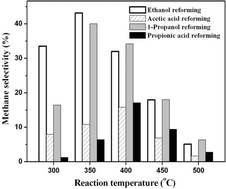Inhibition of methane formation in steam reforming reactions through modification of Nicatalyst and the reactants
Abstract

* Corresponding authors
a
State Key Laboratory for Oxo Synthesis and Selective Oxidation, Lanzhou Institute of Chemical Physics, Chinese Academy of Sciences, Lanzhou, P. R. China
E-mail:
gxlu@lzb.ac.cn
Fax: +86 931 4968178
b Graduate School of Chinese Academy of Sciences, Beijing, P. R. China

 Please wait while we load your content...
Something went wrong. Try again?
Please wait while we load your content...
Something went wrong. Try again?
X. Hu and G. Lu, Green Chem., 2009, 11, 724 DOI: 10.1039/B814009J
To request permission to reproduce material from this article, please go to the Copyright Clearance Center request page.
If you are an author contributing to an RSC publication, you do not need to request permission provided correct acknowledgement is given.
If you are the author of this article, you do not need to request permission to reproduce figures and diagrams provided correct acknowledgement is given. If you want to reproduce the whole article in a third-party publication (excluding your thesis/dissertation for which permission is not required) please go to the Copyright Clearance Center request page.
Read more about how to correctly acknowledge RSC content.
 Fetching data from CrossRef.
Fetching data from CrossRef.
This may take some time to load.
Loading related content
